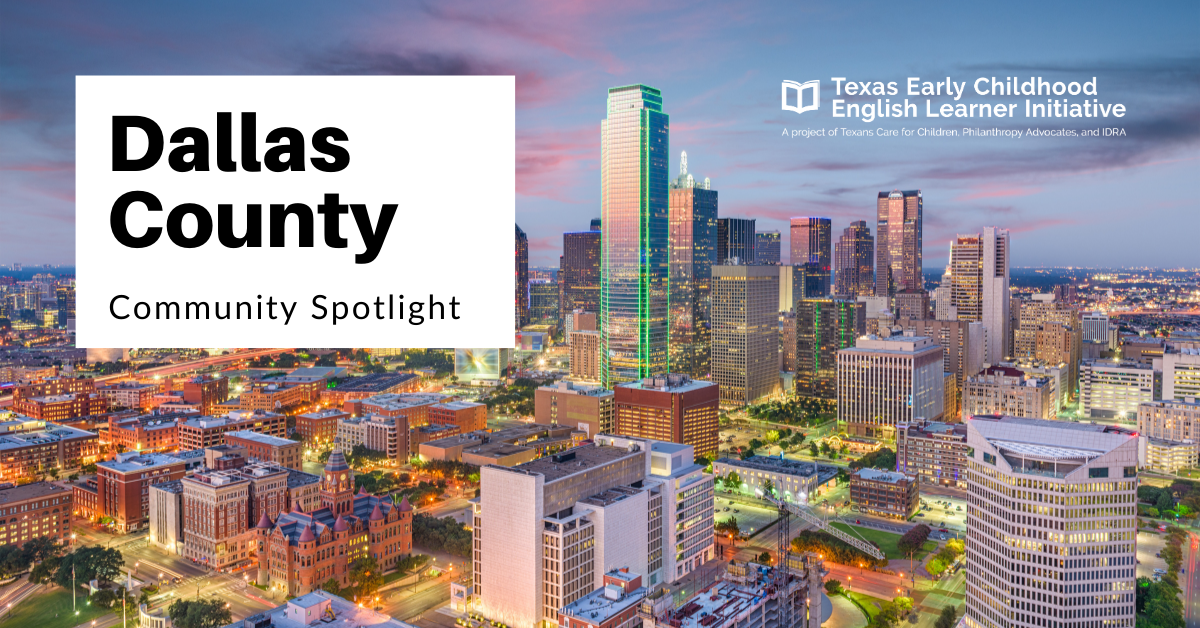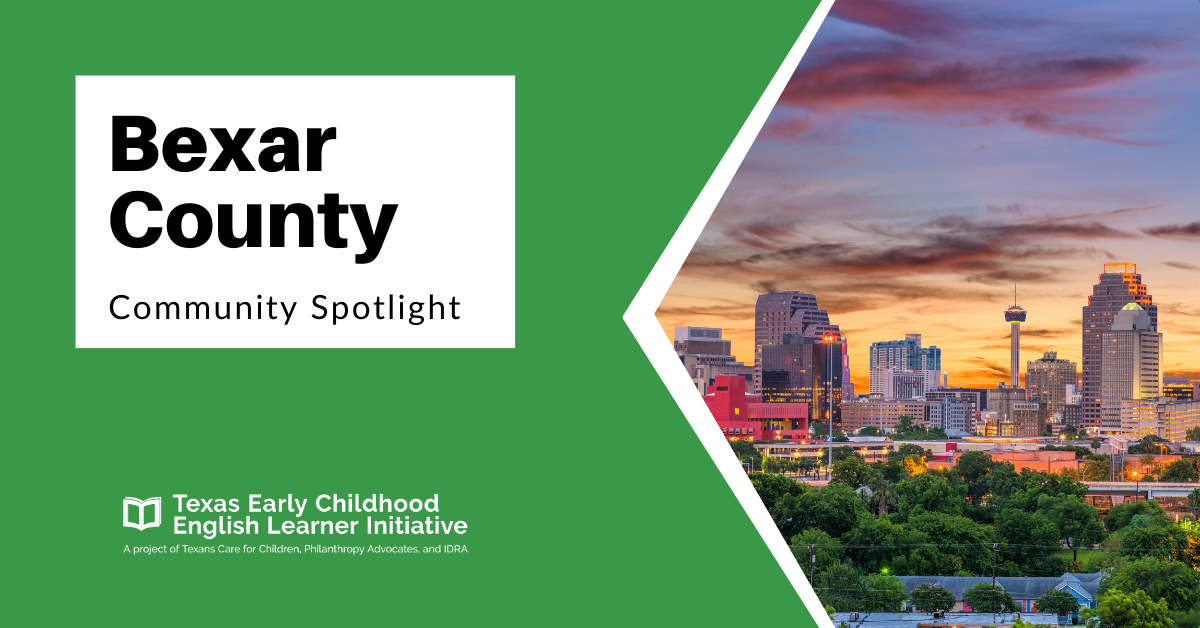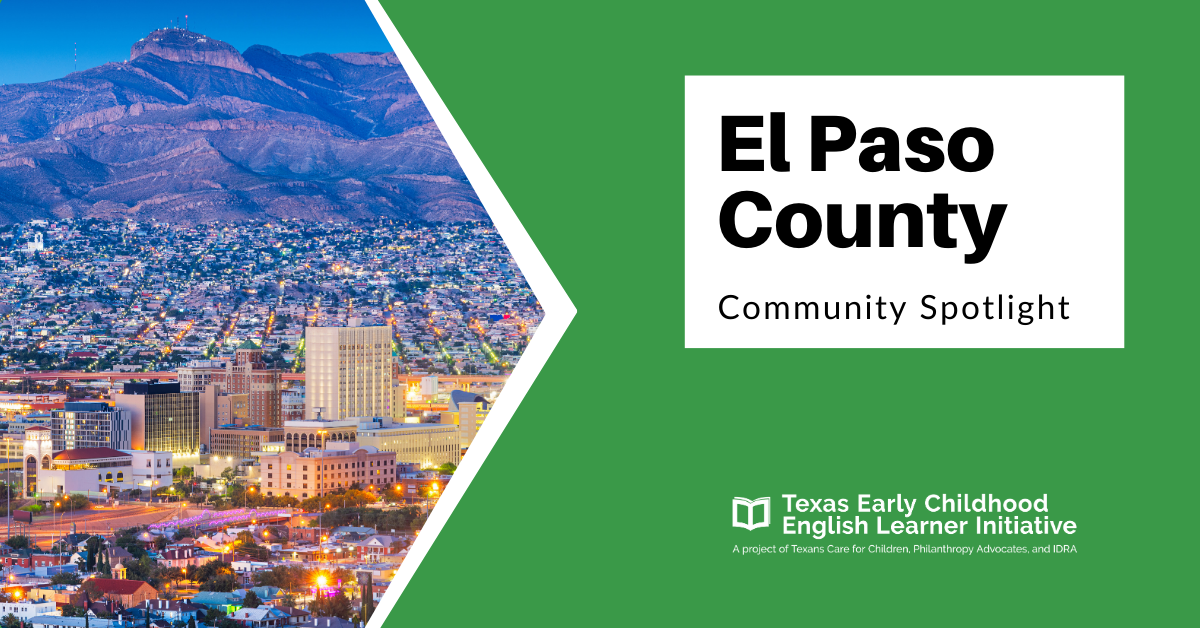Dallas County Spotlight
As a diverse community, Dallas County has among the largest concentrations of English Learners in the state. The region also faces typical challenges serving these children, including shortages in quality child care and struggles retaining a quality early education workforce. However, the region has been a statewide leader in taking regional lessons learned and sharing them with other communities and state leaders to inform policy moving forward.
For example, Dallas County has taken the following critical steps forward:
They seek to support quality teacher-child interactions by incorporating the use of the Classroom Assessment Scoring System (CLASS), a research-based tool for assessing and improving quality in early learning programs. According to community leaders, prior to COVID-19, approximately 60 percent of pre-k students in Dallas were in a classroom that incorporates the CLASS tool.
Nine of the county’s 14 school districts were implementing some full-day pre-k before it was required and funded by the Legislature. With the additional support from HB 3, all 14 districts will be offering full-day pre-k to eligible four-year olds, an extraordinary boost to the early learning possibilities for all children, but especially English Learners.
Despite the region’s successes, access to high-quality child care remains far too low. Many districts have not implemented quality dual language programs across their early learning settings. Hiring and retaining high-quality bilingual educators remains a significant challenge.
Nonetheless, the county provides examples of regional coordination and innovation that continue to inspire change not just within their own community, but throughout the state.
By the Numbers
-
Percent of Pre-k-3rd Grade Students designated as ELs:
Dallas County: 40%
Dallas ISD: 49%
Garland ISD: 46%
Irving ISD: 59%
Statewide: 27%Limited English Speaking Households and Language:
Dallas County: 24.2%
Statewide: 7.44% -
ISD Bilingual/ESL Programs:
Dallas ISD: Dual language one-way and two-way, ESL
Garland ISD: Transitional late exit, Dual langugage one-way and two-way, ESL
Irving ISD: Transitional early exit, Dual langauge two-way, ESLAverage Pre-k Class Size:
Dallas ISD: 18
Garland ISD: 20
Irving ISD: 18Percent of 4-year olds in Full-day Pre-K*:
Dallas ISD: 99.94%
Garland ISD: 8.42%
Irving ISD: 0%
Statewide: 60%*HB 3 required districts offer full-day pre-k to eligible 4-year olds, with available waivers, beginning in the 19-20 school year
-
Provider breakdown:
TRS Providers: 189
Non-TRS Providers: 378
Providers: 567
Percent TRS: 33.3%Statewide:
TRS Providers: 2,059
Non-TRS PRoviders; 5,131
Percent TRS: 28.6%Average children per day:
TRS Average: 5,001
Non-TRS Average: 6,361
Combined Average: 11,362
Percent TRS: 44.0%Statewide:
TRS Average: 56,318
Non-TRS Average: 78,678
Percent TRS: 41.7%
Local Successes and Models
We took a closer look at two local programs to better understand how this community is addressing the education of English Learners during the first eight years of childhood and to identify potential examples for the rest of the state to consider. We conducted a series of interviews with local leaders and gathered available regional data. We are grateful to leaders at Dallas ISD, Momentous School, Lumin Education, and Early Matters Dallas for sharing their insights with us.
-
Dallas ISD, which offers one of the largest comprehensive Dual Language Immersion programs for English Learners in the country, is often considered one of the state’s leaders for providing quality early education for children. Some of the steps Dallas ISD has taken that set examples of local innovations for state policymakers include: Offering full-day pre-k to nearly all eligible four-year olds; building quality data collection, standards, and progress monitoring into their early learning programs; and overseeing 39 different partnership sites with quality child care programs.
Due to the longstanding shortage of certified bilingual educators, the district developed a partnership with Spain, Mexico, Puerto Rico, and other countries and communities around the world to bring educators to the District for three years to lend their expertise to their early learning programs. Although it would be preferable to recruit more Texas certified bilingual educators, initiatives like this, as well as aggressive recruitment strategies, have helped to significantly reduce the shortage for their District.
Additionally, the District has taken important strides to emphasize progress monitoring and data collection. The District has led an effort for campuses to monitor and respond to student progress on a weekly basis, in what they call “Look Forward and Look Back” meetings. These meetings, which they’ve scaled across schools in the district, allow educators to assess how students performed in the past week and how lesson planning needs to adjust in the following week. According to district leaders, the effort has been very beneficial to educators and students, particularly English Learners. Administrators are considering ways that these meetings can more meaningfully assess progress in language development, including for those children who are English Learners.
Dallas ISD’s leaders are continuing to assess how they can provide more quality instruction, close achievement gaps, and engage partners regionally and across the state in strategies to reach those goals.
-
The Momentous School in Dallas is a nationally-accredited, private laboratory school that serves children from age three to fifth grade. As a laboratory school, they partner with the Momentous Institute, which works to build and repair social emotional health through education, therapeutic services, research, and training. The vast majority of the students enrolled are eligible for free and reduced lunch, and 97 percent of the student population is Hispanic.
Momentous is known for its work to build social emotional learning into its curriculum. Using decades of mental health research, they center lessons for children to understand how their brains work, how to manage and control their emotions, how to practice positive relationships, and much more.
Momentus is also known in the community for using a two-generation model that aims to support children and the adults in their lives. Through that work, the school provides parents and caregivers the opportunity to learn more about parenting and offers bilingual instruction for the entire household. The intentional focus on the family is a recognition that parents are their children’s first and primary caregiver, and that language development, as well as supporting a healthy, happy child, starts at the home.
Their work in the classroom is strengthened by a partnership with the bilingual language department at the University of Texas at Dallas. That partnership helps Momentous track children’s development in English and Spanish if parents who opt into that assessment. Through this progress monitoring, Momentous can track students’ growth in English and Spanish development from their entry as early as pre-k through their final day of enrollment in fifth grade. Although they do not offer dual language education, they have worked to emphasize cultural responsiveness and an ability to meet students and families where they are in terms of language and culture.
-
Focusing on supporting young children and centering families in their kids’ education, Lumin has two primary dimensions: their school and their home visiting program. Their public charter school serves children from ages three to nine using a Montessori approach. Montessori education is known for its mixed-age classrooms, support of student choice and empowerment, and teaching concepts through hands-on education, rather than one-way instruction. At Lumin, that means that children are with their teacher for up to three years. Each classroom has two educators, including at least one who is a native Spanish speaker. Serving a high percentage of children who are in Spanish-speaking households, Lumin ensures that classroom environments celebrate and honor children’s home languages, while also supporting English acquisition.
They also emphasize empowering parents to participate in their children’s education. Through their robust home visiting programs, serving around 300 families in the Dallas area, they begin working with low-income families during pregnancy, up to age three. They implement the Parents as Teachers model, a home-visiting framework that certifies professional parent educators who help families through personal visits, group connections, screenings, and referrals to services to ensure infants and toddlers get off to a strong developmental start. Emphasizing the importance of working with the families of English Learners, 90 percent of their parent educators are bilingual Spanish-speakers.
Assessing how they can better serve these children and families, Lumin recently launched a three-year research project with Southern Methodist University, focused on assessing 42 years of longitudinal student data and creating a data dashboard to track school readiness and academic achievement to understand what is working well and where professional development needs to be ramped up. In assessing student progress, they are examining academic growth, social emotional development, executive functioning, and more.
“We're looking at how English learner children, from pre-k on, how their kindergarten readiness is measured, how their third grade reading proficiency is measured, and whether we are building a culture from the very beginning of recognizing and celebrating the emerging bilingualism that is occurring.”
— Dr. Elena Hill, Dallas ISD



